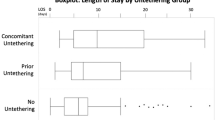Abstract
Study design
Retrospective review of a prospective database.
Purpose
To determine the rate of short-term surgical complications in the 3-month postoperative period in patients with myelomeningocele (MMC) who underwent surgical correction of spine deformities.
Methods
This study reviewed the medical records of MMC patients, aged ≤ 18 years, who underwent spine deformity correction between 2012 and 2018. Clinical, radiological, and surgical variables were considered.
Results
Forty-six patients with primary preoperative curve, pelvic obliquity, and kyphosis mean values of 84.9º, 21.5º, and 76.1º, respectively, were included. Thirty-four (74%) patients underwent scoliosis correction and 12 (26%), kyphectomy. A trend in reduction of %EBV (estimated blood volume) loss with antifibrinolytic use from 50.2 ± 32.3 to 33.8 ± 17.2% was observed (p = 0.103). Simultaneous detethering was performed in 13 (27.7%) patients and was not associated with higher short-term complication rates. There were 12 cases of short-term surgical complications (26.1%); among them, six had deep wound infection requiring surgical debridement, and one a superficial wound infection. Drainage time longer than 4 days was significantly associated with wound infection (OR = 15.8, p = 0.01).
Conclusions
The surgical treatment of neuromuscular scoliosis in MMC patients is challenging because of the high comorbidity rate. Still, we found an admissible rate of short-term surgical complications with a multidisciplinary approach in a setting with extensive spine deformity surgery experience.



Similar content being viewed by others
References
Mohamad F, Parent S, Pawelek J, Marks M, Bastrom T, Faro F, Newton P (2007) Perioperative complications after surgical correction in neuromuscular scoliosis. J Pediatr Orthop 27:392–397
Mummareddy N, Dewan MC, Mercier MR, Naftel RP, Wellons JC 3rd, Bonfield CM (2017) Scoliosis in myelomeningocele: epidemiology, management, and functional outcome. J Neurosurg Pediatr 20:1–10
Canaz H, Alatas I, Canaz G, Gumussuyu G, Cacan MA, Saracoglu A, Ucar BY (2018) Surgical treatment of patients with myelomeningocele-related spine deformities: study of 26 cases. Childs Nerv Syst 34:1367–1374
Winter RB, Pinto WC (1986) Pelvic obliquity, Its causes and its treatment. Spine 11:225–234
Caldarelli M, Boscarelli A, Massimi L (2013) Recurrent tethered cord: radiological investigation and management. Childs Nerv Syst 29:1601–1609
Boachie-Adjei O, Lonstein JE, Winter RB, Koop S, vanden Brink K, Denis F (1989) Management of neuromuscular spinal deformities with Luque segmental instrumentation. J Bone Jt Surg Am 71:548–562
Broom MJ, Banta JV, Renshaw TS (1989) Spinal fusion augmented by Luque-rod segmental instrumentation for neuromuscular scoliosis. J Bone Jt Surg Am 71:32–44
Jain A, Sullivan BT, Kuwabara A, Kebaish KM, Sponseller PD (2017) Sacral-alar-iliac fixation in children with neuromuscular scoliosis: minimum 5-year follow-up. World Neurosurg 108:474–478
Ollesch B, Brazell C, Carry PM, Georgopoulos G (2018) Complications, results, and risk factors of spinal fusion in patients with myelomeningocele. Spine Deform 6:460–466
Ward JP, Feldman DS, Paul J, Sala DA, Errico TJ, Otsuka NY, Margiotta MS (2017) Wound closure in nonidiopathic scoliosis: does closure matter? J Pediatr Orthop 37(3):166–170
Rumalla K, Yarbrough CK, Pugely AJ, Koester L, Dorward IG (2016) Spinal fusion for pediatric neuromuscular scoliosis: national trends, complications, and in-hospital outcomes. J Neurosurg Spine 25:500–508
Martin CT, Pugely AJ, Gao Y, Ilgenfritz RM, Weinstein SL (2014) Incidence and risk factors for early wound complications after spinal arthrodesis in children: analysis of 30-day follow-up data from the ACS-NSQIP. Spine (Phila Pa1976) 39:1463–1470
Master DL, Son-Hing JP, Poe-Kochert C, Armstrong DG, Thompson GH (2011) Risk factors for major complications after surgery for neuromuscular scoliosis. Spine Phila Pa (1976) 36:564–571
Turturro F, Montanaro A, Calderaro C, Labianca L, Di Sanzo V, Ferretti A (2017) Rate of complications due to neuromuscular scoliosis spine surgery in a 30-years consecutive series. Eur Spine J 26:539–545
McLeod L, Flynn J, Erickson M, Miller N, Keren R, Dormans J (2016) Variation in 60-day readmission for surgical-site infections (SSIs) and reoperation following spinal fusion operations for neuromuscular scoliosis. J Pediatr Ortho 36:634–639
Berry JG, Glotzbecker M, Rodean J, Leahy I, Hall M, Ferrari L (2017) Comorbidities and complications of spinal fusion for scoliosis. Pediatrics 139. pii:e20162574
Petersen PA, Marcon RM, Letaif OB et al (2020) Does kyphectomy improve the quality of life of patients with myelomeningocele? Clin Orthop Relat Res 478(1):104–111
Ramo BA, Roberts DW, Tuason D et al (2014) Surgical site infections after posterior spinal fusion for neuromuscular scoliosis: a thirty-year experience at a single institution. J Bone Jt Surg Am 96(24):2038–2048
Hatlen T, Song K, Shurtleff D, Duguay S (2010) Contributory factors to postoperative spinal fusion complications for children with myelomeningocele. Spine 35(13):1294–1299
Acknowledgements
The authors gratefully acknowledge Mrs. Erika Carvalho Pires Arci for her valuable statistical assistance.
Funding
No funding was received for this work.
Author information
Authors and Affiliations
Contributions
AOdA, DF, LMRD, RGdO: Made substantial contributions to the conception or design of the work; or the acquisition, analysis, or interpretation of data; or the creation of new software used in the work. AOdA, CRG, DF, EVMB, LMRD, RGdO: Drafted the work or revised it critically for important intellectual content. AOdA, CRG, DF, EVMB, LMRD, RGdO: Approved the version to be published. AOdA, CRG, DF, EVMB, LMRD, RGdO: Agree to be accountable for all aspects of the work in ensuring that questions related to the accuracy or integrity of any part of the work are appropriately investigated and resolved.
Corresponding author
Ethics declarations
Conflict of interest
The authors declare that there is no conflict of interest.
Ethical approval
Research Ethics Committee approval: 08053919.0.0000.0022.
Rights and permissions
About this article
Cite this article
de Araújo, A.O., Gomes, C.R., Fava, D. et al. Short-term surgical complications of spinal fusion in myelomeningocele. Spine Deform 9, 1151–1159 (2021). https://doi.org/10.1007/s43390-021-00304-8
Received:
Accepted:
Published:
Issue Date:
DOI: https://doi.org/10.1007/s43390-021-00304-8




